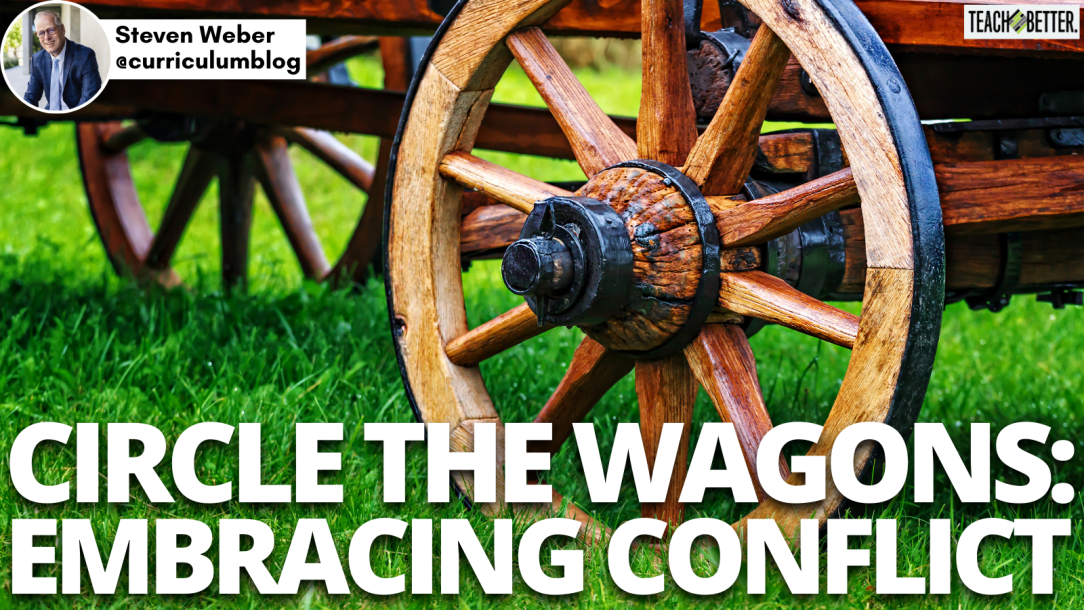TL;DR:
- Having productive debates and conflicts can help teams move beyond the status quo.
- This can be difficult because, unlike the corporate world, teachers have little time within the day to collaborate.
- Constructive collaboration is necessary to move teachers forward rather than avoiding conflict because it is easier.
Show me which topic or issues cause your school staff to “Circle the Wagons,” and we can quickly identify what matters. Grade-level teams, departments, and school improvement teams meet on a regular basis to make important decisions related to teaching and learning. The schedule of most schools creates a conflict-resistant environment. However, in a corporate setting, employees may brainstorm daily at 10:00 am, challenge ideas over a two-hour lunch, or conduct a full-day meeting without having to create sub plans. In most school systems, educators work directly with students between 8:00 am – 4:00 pm. This means that adult meetings take place before school, during a brief break, or after a full day of teaching students. Therefore, it can be stressful to challenge a colleague after a full day of teaching students. Meetings become a checklist rather than a debate or opportunity to address a problem of practice.
Conflict or Collegiality
Does your team embrace conflict or collegiality? Simply scheduling a weekly team time or collaborating with your colleagues will not support continuous improvement. “For good ideas and true innovation, you need human interaction, conflict, argument, debate” (Heffernan, 2012). Some teams have a sense of urgency regarding student growth, instructional strategies, and team goals, but they deliberately avoid conflict.
Why would dedicated and passionate educators avoid a spirited debate and conflict? There is limited time during work hours to challenge a colleague or an instructional strategy. For example, some elementary teams may have a 30-minute planning meeting resulting in little time for conflict and problem-solving. Unlike the corporate world, adult interactions are limited. For instance, it may be 24 hours or more before the conversation can be revisited. School teams prefer to support one another. Therefore, conflict can be seen as an enemy of teamwork rather than a tool to help the team’s goal of preparing each learner for the next level.
School teams prefer to support one another. Therefore, conflict can be seen as an enemy of teamwork rather than a tool to help the team’s goal of preparing each learner for the next level. Click To TweetCelebration Versus Disagreement
Barth (2006) wrote, “A precondition for doing anything to strengthen our practice and improve a school is the existence of a collegial culture in which professionals talk about practice, share their craft knowledge, and observe and root for the success of one another.” Does your team emphasize cheering for one another over conflict? Most adults prefer to attend meetings where there is little resistance, decisions come from consensus, and each member of the team feels good about the meeting. “There’s no point in collaboration without tension, disagreement, or conflict. What we need is collaboration where tension, disagreement, and conflict improve the value of the ideas, expose the risks inherent in the plan, and lead to enhanced trust among the participants” (HBR Ascend, 2017). Some school teams maintain the status quo because they do not take time to disagree.
3 Reasons Teams Should Embrace Conflict
- Teams should have a sense of urgency about what matters most.
- Challenging an idea or plan may be the tipping point that allows a group of educators to support more students.
- Teaching and learning require educators to design better systems, not simply cross a finish line.
Five Questions for School Teams
If your team does not currently embrace conflict, consider asking one of these questions:
- What do we have a sense of urgency about this week?
- Which instructional strategies have the highest impact on student understanding during this unit?
- What are we doing to support the students who are reading below grade level?
- What is the “Elephant in the Room” that we must address?
- Do we have lofty goals or collective commitments? What are we committed to?
Continuous Improvement
If school teams develop team norms and agree to disagree when it comes to important matters related to teaching and learning, they will begin to see conflict as a method for continuous improvement. Parents, taxpayers, and community leaders depend on teachers and administrators to have hard conversations that support the students they are entrusted to educate. The question should not be “How can we avoid conflict?” but “What’s worth fighting for?”
References
Barth, R. (2006). Improving relationships within the school house. Educational Leadership. Retrieved from https://www.ascd.org/el/articles/improving-relationships-within-the-schoolhouse.
HBR Ascend. (2017). If your team agrees on everything, working together is pointless. Retrieved from https://medium.com/@hbrascend123/if-your-team-agrees-on-everything-working-together-is-pointless-98c67a246d4e
Heffernan, M. (2012). Dare to disagree. YouTube. Retrieved from https://www.youtube.com/watch?v=PY_kd46RfVE.
About Steven Weber
Dr. Steven Weber is a curriculum leader. He has served on multiple state and national boards. His areas of research include curriculum design, multiplying leaders, professional learning, and school leadership.




